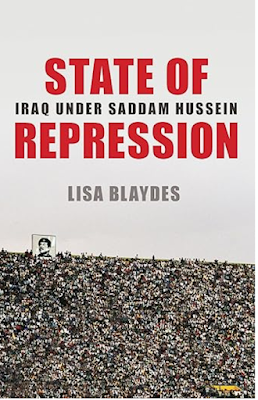Blaydes, Lisa, State Of Repression, Iraq Under Saddam Hussein, Princeton University Press, 2018
Lisa Blaydes’ State Of Repression, Iraq Under Saddam Hussein takes new approaches to analyzing the rule of the Baath Party and Saddam Hussein. Like recent books it argues that the Baath and Saddam ruled through a combination of carrots and sticks. What the author focuses upon is how those two approaches formed political identities in the country. She argues that those parts of Iraqi society that were easily penetrated by the state faced more nuanced acts of repression while those that were more difficult suffered collective punishment which led to new political communities being formed.
State Of Repression lays out a general history of Iraq under Baathist rule that provides a background to the author’s thesis. The author starts in the 1970s when Iraq was flush with oil money and spent much of it upon economic development turning the country into a middle income nation. The rising standard of living won widespread loyalty for the state as people were able to take advantage of new schools, services and government jobs.
That all changed in the following decades. In 1980 Saddam invaded Iran and miscalculated how Tehran would respond leading to a devastating eight year war. At the same time in 1986 oil prices collapsed. The government wasn’t able to expend the same amount of largesse to its population and had to make dramatic cutbacks instead. Things were made worse by the Gulf War and United Nations sanctions that lasted until 2003. Saddam had to cut back his military leading to new fissures within those close to the state. Some of those that felt excluded turned to resistance.
Blaydes then applies her ideas of state co-option and repression throughout these time periods. She writes that the Sunni community was more easily penetrated by the state which relied upon Sunni tribes in and around Saddam’s home territory of Tikrit and Salahaddin province. Sunnis from other provinces were also given preference in the military. In the 1990s when the military went through a large demobilization because the government wasn’t able to sustain it anymore under sanctions several tribes from Ninewa and Anbar provinces felt like they were being cut off from patronage and carried out a series of assassination and coup attempts. Those all failed because the community was easily surveilled by the government. Punishments were carried out against individuals and their families such as rebellious generals and other officers because the state largely knew who was responsible.
The Kurds and the Shiite religious establishment on the other hand were harder for the government to interpret. Kurds lived in a mountainous region with various tribes and chieftains. Shiite clerics were based upon families and their followers and also had international students and supporters which the government found harder to control. When Kurds and Shiite religious parties rebelled against the government it used collective punishment because it was unable to discern the individuals responsible like it could for Sunni army officers.
At the end of the Iran-Iraq War for instance, Saddam decided to destroy the Kurdish rebels in the Anfal campaign which saw large deportations of communities, mass executions and widespread use of chemical weapons. Blaydes argues this united the Kurdish community which had major fissures before and created a new widespread sense of Kurdish nationalism.
Likewise in the 1990s Saddam assassinated a leading cleric Ayatollah Mohammed Sadiq al-Sadr. His followers protested and rioted afterwards leading to group punishments which solidified the support for Sadr’s family which would play out after the 2003 invasion as the ayatollah’s son Moqtada al-Sadr would emerge as the only mass based political leader in the country. Communities which the state could not thoroughly surveil faced harsher punishments than those that could be and in turn led to new political identities being created such as Kurdish nationalists and Sadrists.
Blaydes has a plethora of information to back up her arguments based upon the captured Baathist documents that were brough to the U.S. after 2003. There are charts for example about how many casualties were suffered by different provinces during the Iran-Iraq War, how clerics were ranked by the government as being loyal or not in the 1990s, and surveys of high school students about whether they affiliated as Baathists or independents.
The only chapter that really falters in State of Repression is one on rumors the state collected. Blaydes writes that rumors are an important part of life in totalitarian governments because they show levels of dissent and alternative news sources from the state. It wasn’t half as interesting as the other sections however because it’s just a collection of stories passed around.
State Of Repression adds to the analysis about Baathist rule in Iraq. Blaydes’ argument about how the government was able to co-opt large sections of the population builds upon other authors. Her scholarship on how repression was meted out differently and how that led to new communities being formed is new and original. It makes the book a must read for scholars on Iraq and has implications for how Iraqi politics played out after 2003 as the author goes over in her conclusion. It is highly recommended.
Link to all of Musings On Iraq’s book reviews listed by topic





No comments:
Post a Comment